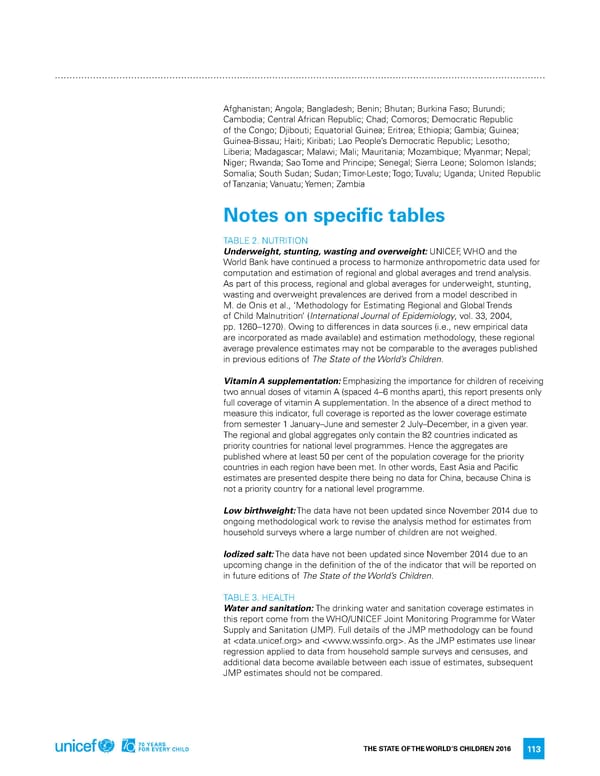Afghanistan; Angola; Bangladesh; Benin; Bhutan; Burkina Faso; Burundi; Cambodia; Central African Republic; Chad; Comoros; Democratic Republic of the Congo; Djibouti; Equatorial Guinea; Eritrea; Ethiopia; Gambia; Guinea; Guinea-Bissau; Haiti; Kiribati; Lao People’s Democratic Republic; Lesotho; Liberia; Madagascar; Malawi; Mali; Mauritania; Mozambique; Myanmar; Nepal; Niger; Rwanda; Sao Tome and Principe; Senegal; Sierra Leone; Solomon Islands; Somalia; South Sudan; Sudan; Timor-Leste; Togo; Tuvalu; Uganda; United Republic of Tanzania; Vanuatu; Yemen; Zambia Notes on specific tables TABLE 2. NUTRITION Underweight, stunting, wasting and overweight: UNICEF, WHO and the World Bank have continued a process to harmonize anthropometric data used for computation and estimation of regional and global averages and trend analysis. As part of this process, regional and global averages for underweight, stunting, wasting and overweight prevalences are derived from a model described in M. de Onis et al., ‘Methodology for Estimating Regional and Global Trends of Child Malnutrition’ (International Journal of Epidemiology, vol. 33, 2004, pp. 1260–1270). Owing to differences in data sources (i.e., new empirical data are incorporated as made available) and estimation methodology, these regional average prevalence estimates may not be comparable to the averages published in previous editions of The State of the World’s Children. Vitamin A supplementation: Emphasizing the importance for children of receiving two annual doses of vitamin A (spaced 4–6 months apart), this report presents only full coverage of vitamin A supplementation. In the absence of a direct method to measure this indicator, full coverage is reported as the lower coverage estimate from semester 1 January–June and semester 2 July–December, in a given year. The regional and global aggregates only contain the 82 countries indicated as priority countries for national level programmes. Hence the aggregates are published where at least 50 per cent of the population coverage for the priority countries in each region have been met. In other words, East Asia and Pacific estimates are presented despite there being no data for China, because China is not a priority country for a national level programme. Low birthweight: The data have not been updated since November 2014 due to ongoing methodological work to revise the analysis method for estimates from household surveys where a large number of children are not weighed. Iodized salt: The data have not been updated since November 2014 due to an upcoming change in the definition of the of the indicator that will be reported on in future editions of The State of the World’s Children. TABLE 3. HEALTH Water and sanitation: The drinking water and sanitation coverage estimates in this report come from the WHO/UNICEF Joint Monitoring Programme for Water Supply and Sanitation (JMP). Full details of the JMP methodology can be found at and . As the JMP estimates use linear regression applied to data from household sample surveys and censuses, and additional data become available between each issue of estimates, subsequent JMP estimates should not be compared. THE STATE OF THE WORLD’S CHILDREN 2016 113
 70 Years for Every Child Page 131 Page 133
70 Years for Every Child Page 131 Page 133